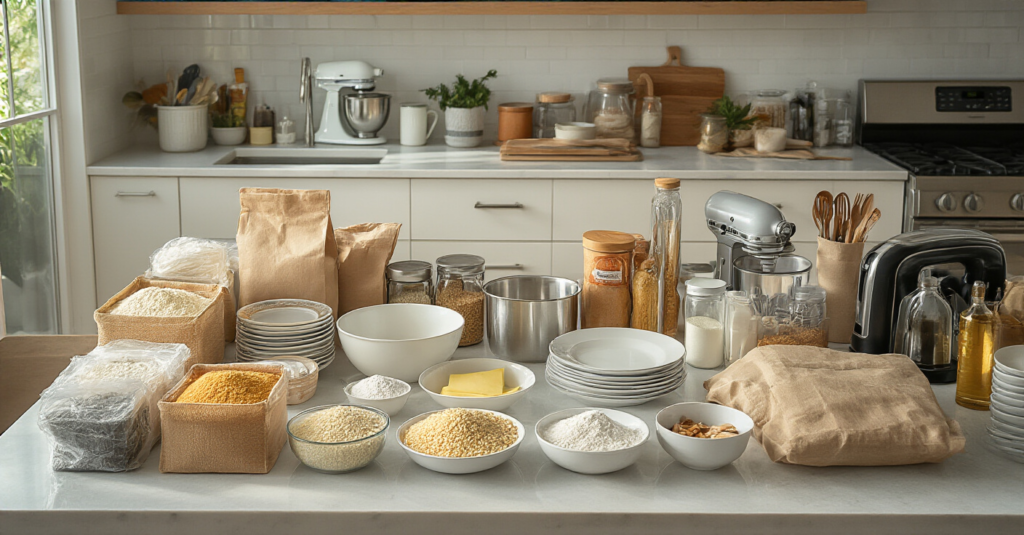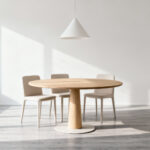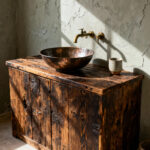Picture this: You’re hosting a dinner party on the patio. The grill is hot, the string lights are glowing, and everyone’s enjoying the cool evening air. Then someone asks for a corkscrew. You head inside, open that one chaotic drawer, and the sound of rattling metal fills the kitchen as you dig past mismatched Tupperware lids and takeout menus. The spell is broken. The effortless flow from your kitchen to your outdoor living space is severed by clutter.
As someone who designs spaces that blend the indoors with the natural world, I can tell you that a functional outdoor room is only as good as its support system. And the kitchen is the engine room. To create a seamless experience, you need to be able to grab what you need without a second thought. Forget the corporate-speak and endless product lists. Here’s what actually matters when it comes to taming your kitchen cabinets so you can get back to enjoying your life, inside and out.
Foundation: Planning for Optimized Cabinet Space (Part 1)
Before you buy a single bin or divider, you need a plan. In landscape design, we call this a site analysis. You wouldn’t start planting a garden without understanding the soil, sunlight, and existing terrain. The same principle applies here. This first phase is about understanding what you’re working with, clearing the debris, and taking precise measurements. Get this right, and everything else falls into place naturally.
1. Conduct a Full Cabinet Inventory: Know What You Truly Own
Let’s be honest. You have no idea what’s really in the back of that corner cabinet. The first step is to pull everything—and I mean everything—out. Get it all onto your dining table or a clear patch of floor. This is your site survey. You need a clear, unvarnished look at the landscape before you can decide what stays, what goes, and what needs a new home.
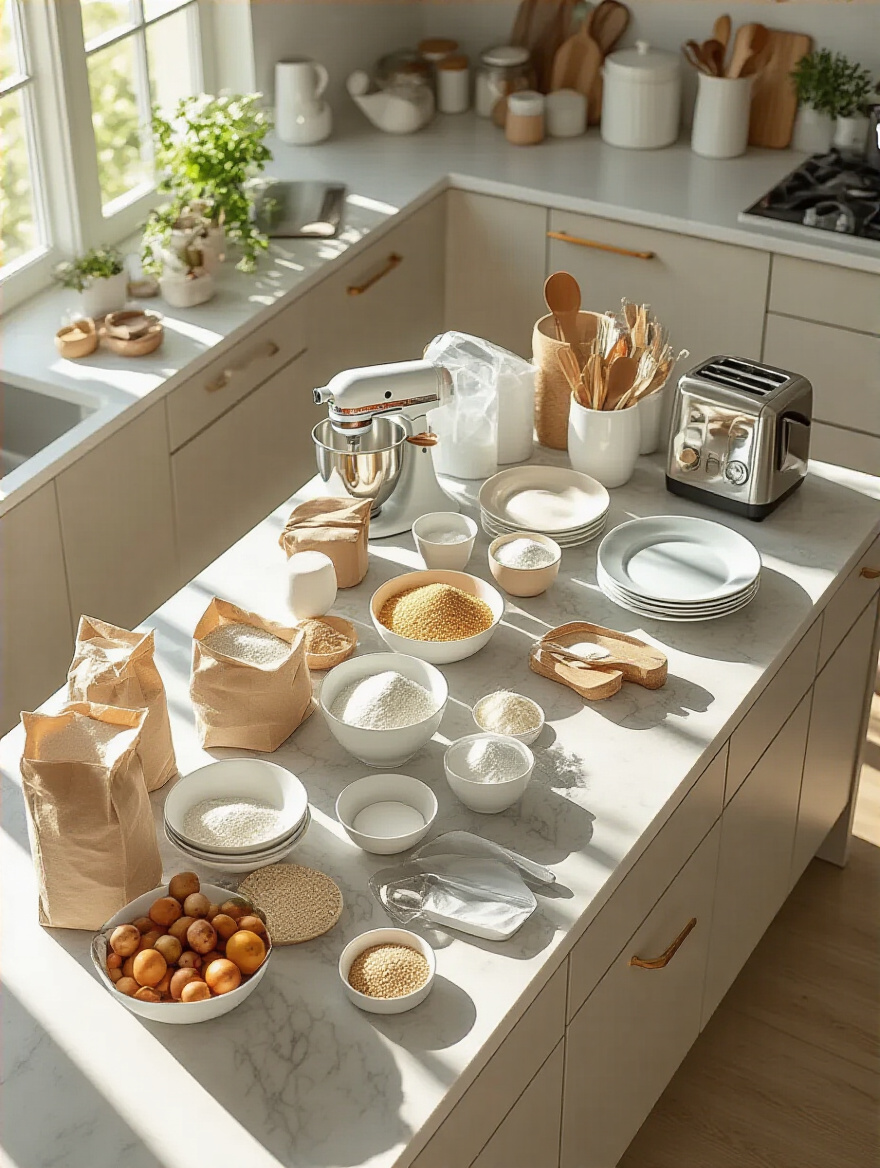
Most people skip this, thinking they have a handle on it. They don’t. They buy organizers for stuff they don’t even need, creating organized clutter. When you see all three of your immersion blenders sitting next to each other, you’ll understand. This step isn’t just about seeing what you have; it’s about confronting what you’ve accumulated. It’s the single most important thing you can do to reclaim your space.
A full inventory forces a reckoning, separating the tools you actually use from the aspirational gadgets that are just collecting dust. Now, let’s talk about clearing the dead wood.
2. Declutter Ruthlessly: Employ the “Keep, Donate, Toss” Method
Now that you can see everything, it’s time to be the unsentimental editor of your own kitchen. This is the weeding phase. A garden choked with weeds can’t thrive, and a kitchen full of unused junk can’t function. Sort every single item into three piles: Keep, Donate, and Toss. No “maybe” pile. A “maybe” pile is just a fast pass back to clutter.
The rule I use is simple: if you haven’t touched it in a year and it isn’t a seasonal specialty item (like a turkey baster), it’s gone. You will not miss the melon baller. I promise. The noise in this space is the emotional attachment to “what if.” What if I need this weird apple-coring device? You won’t. What matters is freeing up valuable real estate for the things you use every single day.
Immediately bag the trash and put the donation box in your car. Do not let it linger. Getting the clutter out of the house is as important as getting it out of the cabinet.
3. Measure Every Dimension: Precision for Perfect Organizer Fit
You wouldn’t build a deck without a tape measure and a level, right? So don’t buy a single organizer without precise measurements. And I don’t mean just a quick width check. You need the internal width, depth, and height. Measure at the front and back, because cabinets aren’t always perfectly square. Most importantly, measure the opening, accounting for the cabinet frame and any intrusive hinges.
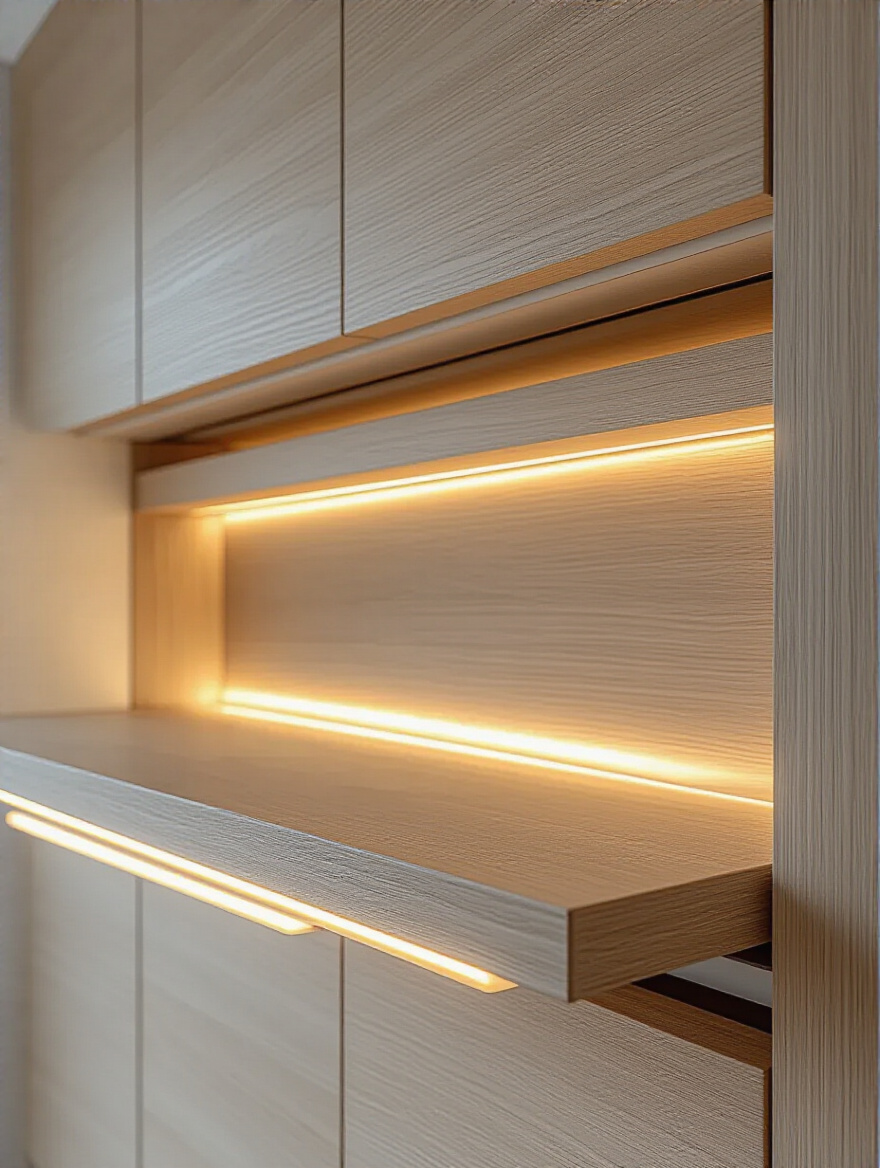
That inside lip of the cabinet frame has thwarted more well-intentioned organizing projects than anything else. People buy a 12-inch-wide pull-out drawer for a 12-inch cabinet, only to find the actual opening is only 10.5 inches. It’s a rookie mistake, and it’s completely avoidable. Write it down. Draw a diagram for each cabinet. Precision here saves you time, money, and the soul-crushing hassle of returns.
With accurate measurements, you’re no longer guessing; you’re engineering a solution. This data will be your blueprint for what comes next.
4. Identify Cabinet Type Challenges: Upper, Lower, Pantry, and Drawers
Just as a garden has different microclimates—shady spots, sun-drenched patches, areas with poor drainage—your kitchen has different types of storage, each with its own challenges. A deep lower cabinet is a black hole for pots and pans. High upper cabinets are where mugs go to be forgotten. A narrow pantry requires a different strategy than a wide-open drawer.
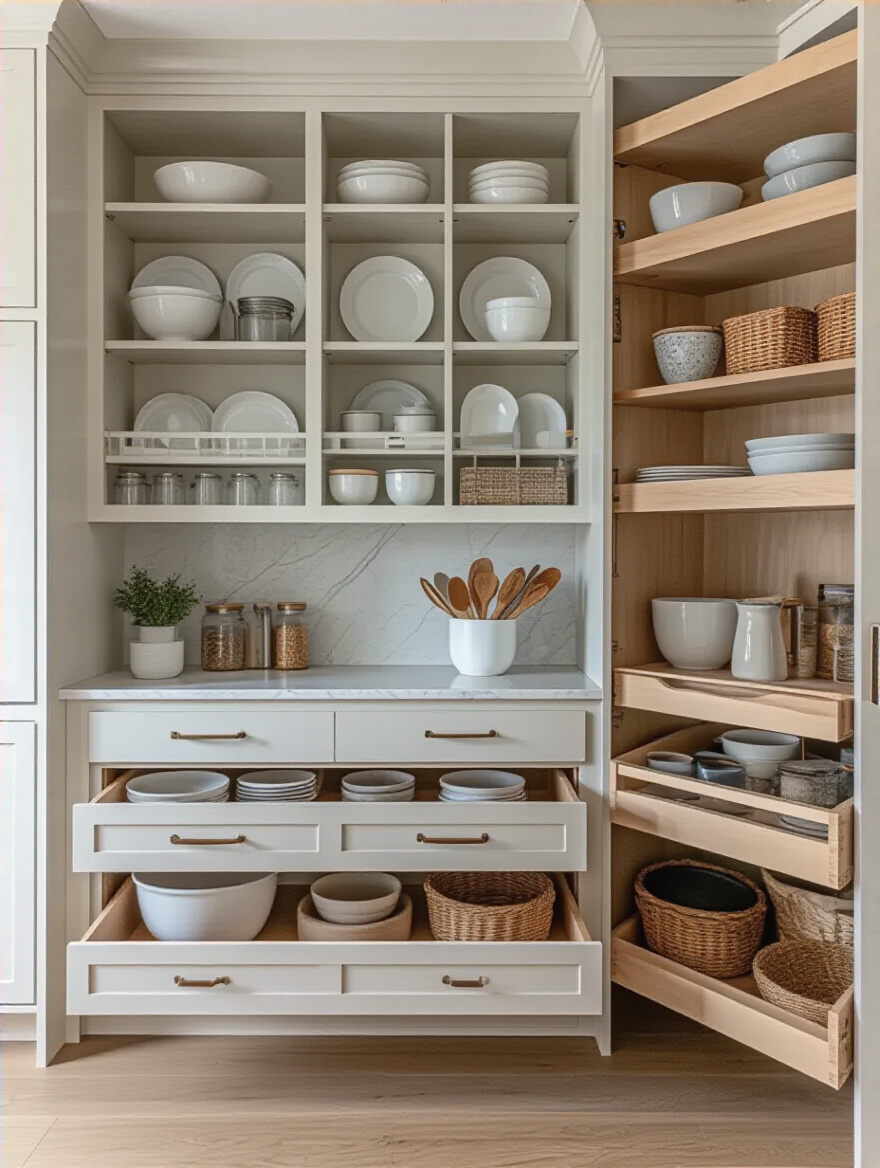
Don’t fall for the “one-size-fits-all” solution. It doesn’t exist. The goal here is to match the solution to the specific environment. Lower cabinets are prime candidates for things that can be pulled out. Upper cabinets are best for lighter, everyday items. Deep pantries need systems that let you see the back. Acknowledging these distinct challenges is the final step in your planning phase.
Understanding the unique typography of your kitchen landscape allows you to choose the right “plant” for the right place, ensuring everything will not only fit, but thrive.
Foundation: Planning for Optimized Cabinet Space (Part 2)
We’ve surveyed the land and cleared the overgrowth. Now, we draw the pathways and plan the garden beds. This part of the foundation is about arranging your space based on how you actually live. It’s about creating an intuitive flow that makes sense to you, not to someone in a catalog. This is where intentional design turns a collection of items into a functional system.
5. Group Similar Items Strategically for Cohesive Storage
This sounds obvious, but you’d be surprised how many people have baking soda in three different places. This principle is what natural gardeners call “plant guilds.” You group plants together that support each other. In the kitchen, you group items together that are used together. All your baking supplies—flour, sugar, vanilla, mixing bowls—live in one zone. All your coffee and tea supplies in another.
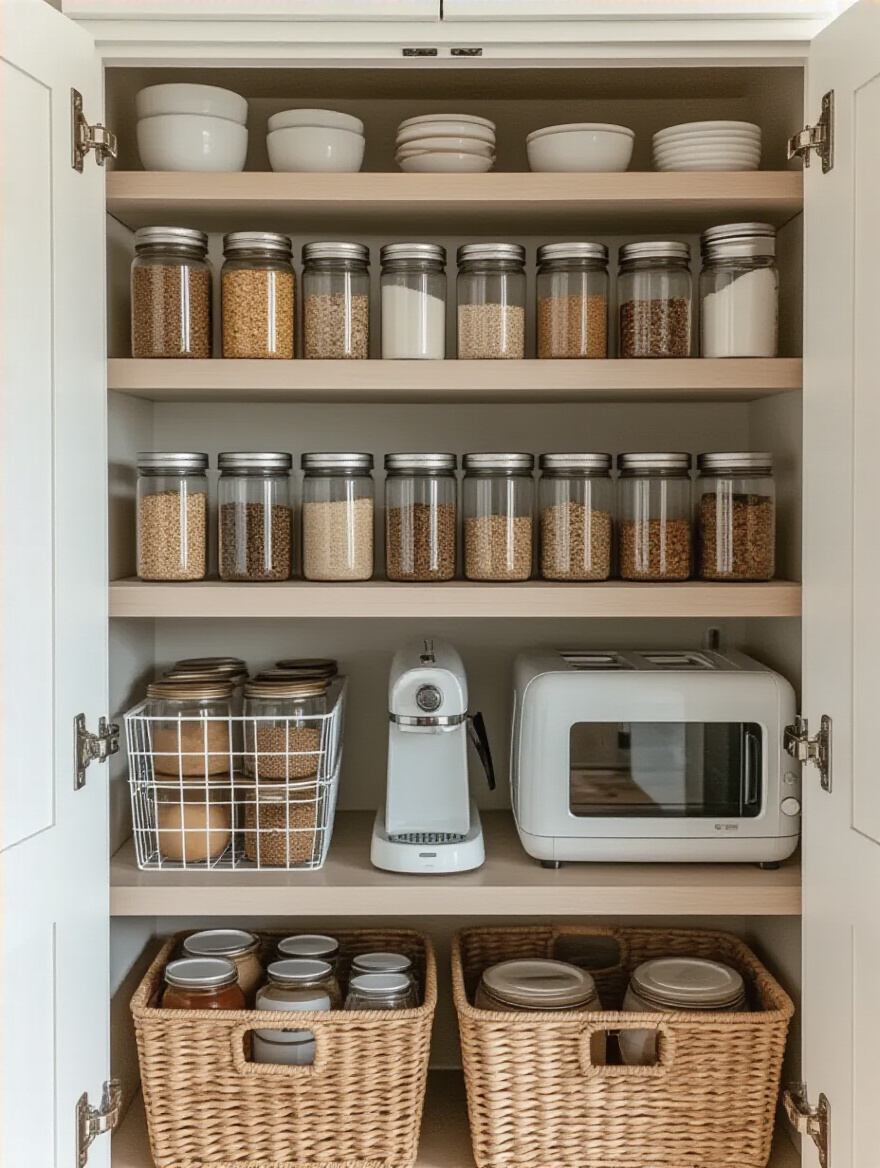
The goal is to create stations. When you want to make coffee, you shouldn’t have to walk to three different spots. You go to the coffee station. This single act of grouping items by function will dramatically reduce the number of steps you take and the amount of mental energy you expend every single day. Stop thinking of your cabinets as random storage boxes and start seeing them as dedicated workstations.
Once your items are grouped, you can begin to think about where these groups should live. This decision shouldn’t be random; it should be based on your daily rhythms.
6. Assess Your Usage Patterns: Prioritize Accessibility for Daily Essentials
In landscape design, we lay pathways where people naturally walk. We don’t force them to take an unnatural route. The same logic applies to your kitchen. The items you use every day—your favorite coffee mug, your go-to frying pan, the kids’ plates—should live in the most accessible, prime real estate. This is the area between your shoulders and your knees.
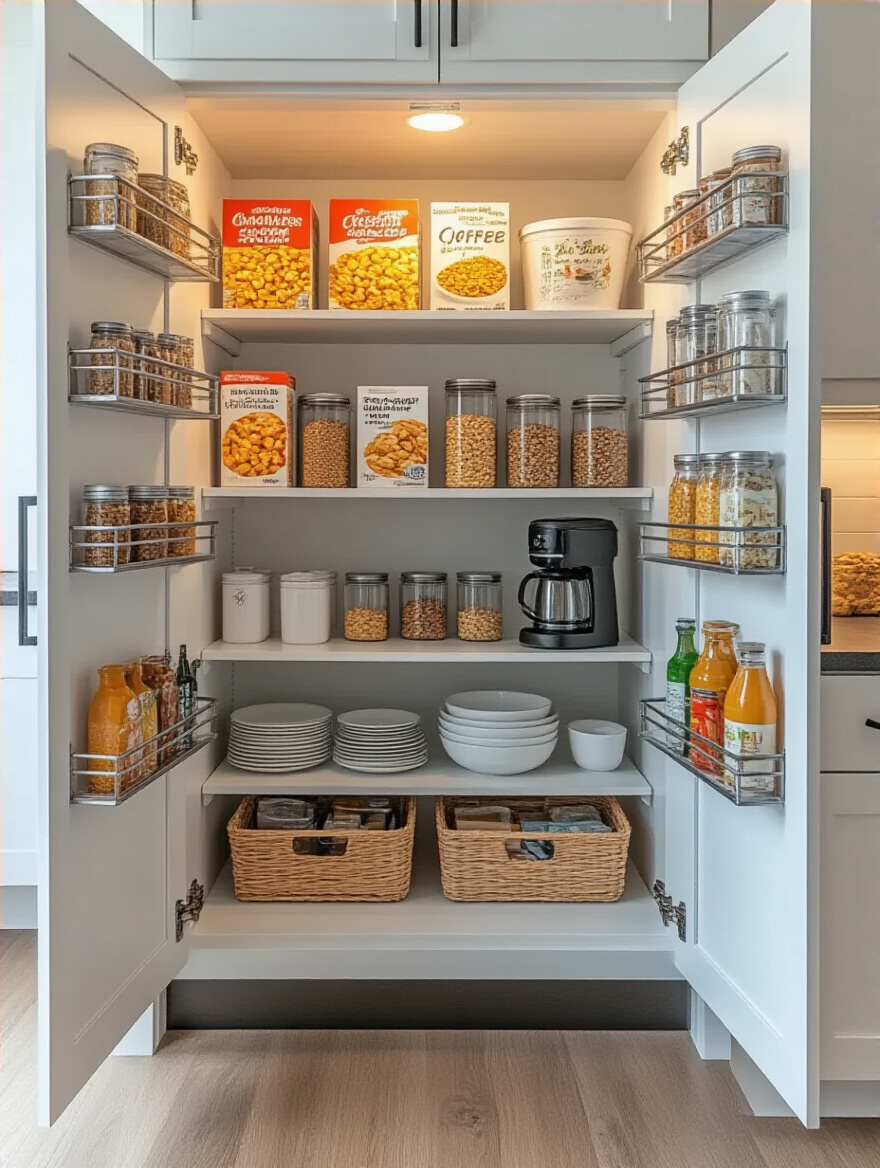
Observe yourself for a day. What do you reach for constantly? That’s the stuff that gets front-and-center placement. Items you use weekly can go a little higher or lower. The things you use a few times a year, like the big roasting pan, can go in the hardest-to-reach spots. This is the most overlooked secret to sustainable organization.
Stop organizing based on what looks pretty and start organizing based on your actual life. It seems simple, but it’s a profound shift. An efficient kitchen should feel like an extension of your own movements, flowing with you, not against you.
Implementation: Smart Storage Solutions for Core Needs (Part 1)
Now that we have a solid plan, we can finally bring in the tools. This is where you get to install the hardscaping—the structures that will define and support your system. The key here is to choose solutions that solve specific problems we identified in the planning phase. Don’t just buy things because they look cool. Buy them because they serve a purpose.
7. Install Pull-Out Drawers for Deep Base Cabinets: Access Rear Items Easily
Base cabinets are the worst offenders in a kitchen. They’re basically dark caves where Tupperware and small appliances go to die. The only real way to fix them is to make the back come to you. Pull-out drawers are non-negotiable for these spaces. They transform a frustrating black hole into 100% accessible storage.
Everyone else will tell you to get some bins. That’s a Band-Aid. Bins still require you to get on your knees and pull them out. A full-extension pull-out system brings the entire contents of the cabinet out into the light with one easy motion. This is the single biggest quality-of-life upgrade you can make to your kitchen’s functionality. It’s worth every penny.
These drawers are perfect for heavy items like pots, pans, and appliances like your stand mixer or Instant Pot. It makes them effortless to access, which means you’ll actually use them more.
8. Utilize Tiered Shelf Risers for Upper Cupboards and Pantry Shelves
So much vertical space in our cabinets is just dead air. A tiered shelf riser is like building a terrace on a hillside. It instantly creates new, visible levels of storage on a single flat shelf. They’re perfect for organizing cans, spices, and jars, allowing you to see everything at a glance. No more discovering a can of soup from 2012 hidden behind the new ones.
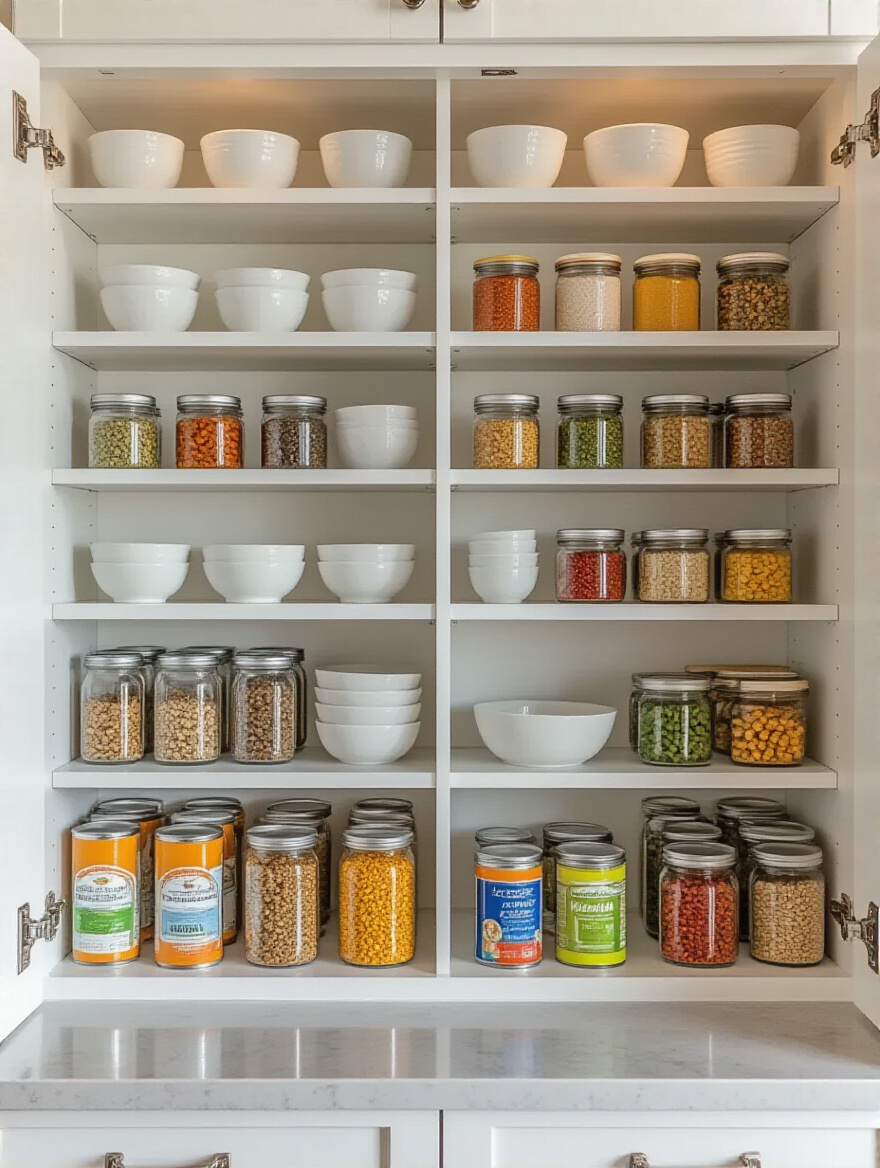
These risers are a cheap, simple, and incredibly effective shortcut. You can double or even triple the visibility of your pantry items instantly. This stops you from buying duplicates of things you already have, saving you money and preventing waste. Look for expandable ones so they can fit your cabinet width perfectly.
Think of it as stadium seating for your canned goods. Everyone gets a front-row view, so nothing gets lost in the crowd. It’s an easy win that makes a huge difference.
9. Employ Door-Mounted Organizers for Spices, Wraps, or Cleaning Supplies
The inside of your cabinet doors is some of the most underutilized real estate in your entire home. It’s the perfect spot for small, lightweight items that tend to clutter up shelves. Door-mounted organizers are fantastic for things like spices, rolls of foil and plastic wrap, or cleaning supplies.
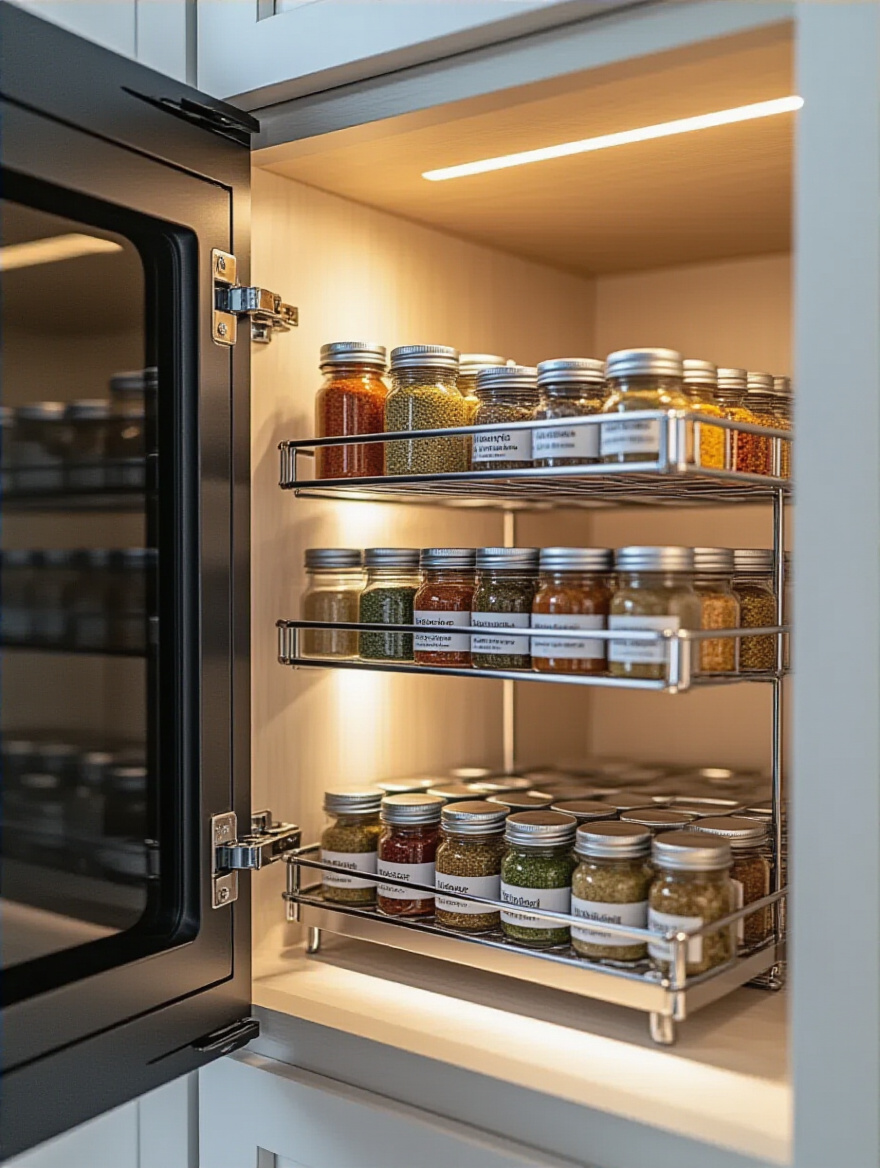
By moving these items to the door, you free up precious shelf space for bulkier things. For spices, it’s a game-changer. Instead of a jumbled mess on a shelf or a lazy Susan, you have a neat library of spices, all visible and easy to grab. The same goes for the under-sink cabinet; moving spray bottles to a door-mounted caddy gets them out of the way of the plumbing.
Just remember the measurements you took. Make sure the organizer is shallow enough that the cabinet door can still close without hitting the items on the shelf inside.
10. Introduce Clear Bins and Containers for Visible Pantry Organization
People love the idea of decanting everything into beautiful matching containers, but here’s what really matters: they have to be clear. The whole point of decanting pasta, rice, and snacks isn’t just aesthetics; it’s about visibility. Clear containers let you see exactly how much you have left at a glance, making your grocery list a breeze.
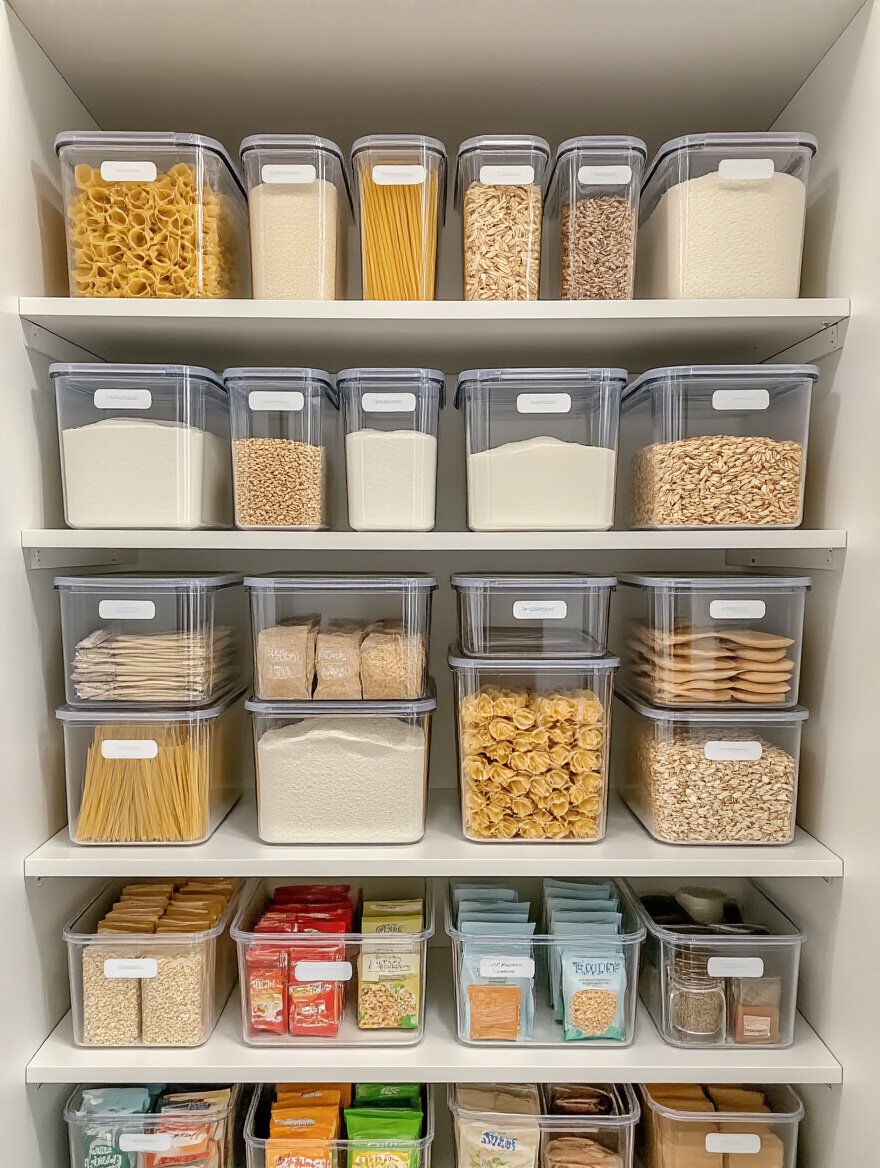
Using clear bins for smaller packaged items—like snack pouches, granola bars, or spice packets—is also brilliant. Instead of having a bunch of half-empty boxes tumbling around, you have one tidy bin for “Snacks” or “Baking Packets.” You can pull the whole bin out, find what you need, and put it back. It contains the chaos.
This isn’t about making your pantry Instagram-perfect. It’s about creating a system where information—what you have and how much of it—is available instantly, with zero effort.
Implementation: Smart Storage Solutions for Core Needs (Part 2)
We’ve laid down the major structural pieces. Now it’s time for the finer details—the finishing touches that provide stability and custom fits. This is like adding the perfect mulch to a garden bed or the gravel that locks pavers into place. These small additions prevent chaos from creeping back in and ensure your system is durable.
11. Divide Deep Drawers with Adjustable Inserts for Custom Compartments
Deep drawers can be just as bad as deep cabinets if you don’t tame them. Without structure, they become a jumbled pit of utensils, food storage containers, and other assorted junk. Adjustable dividers are the answer. They allow you to create custom-sized compartments perfectly tailored to what you need to store.
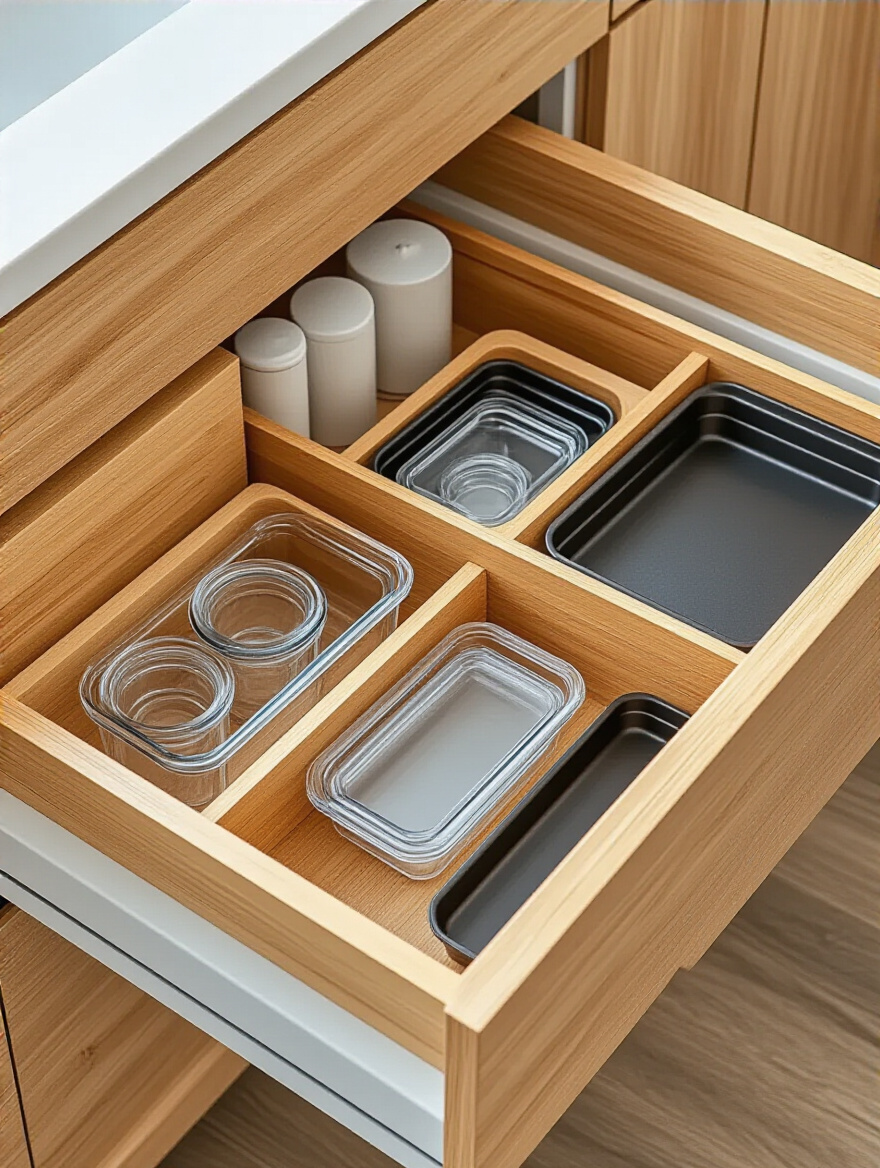
I personally love spring-loaded bamboo dividers. They look great and hold firm, allowing you to create neat rows for food container lids stored vertically, or tidy sections for dish towels and pot holders. The key is adjustable. Your needs will change, and these dividers can change with you. Don’t get locked into a fixed plastic tray that only fits one type of utensil.
This is how you stop the daily frustration of the “lid avalanche” or the search for the one correct spatula. It creates calm out of what is often the most chaotic part of the kitchen.
12. Choose Non-Slip Liners for All Shelves and Drawers to Prevent Movement
This is the one thing everyone skips, and it drives me crazy. Non-slip liners are the unsung heroes of kitchen organization. They do two critical things: they protect the surface of your cabinets and drawers from scratches and spills, and they stop everything from sliding around every time you open or close them.
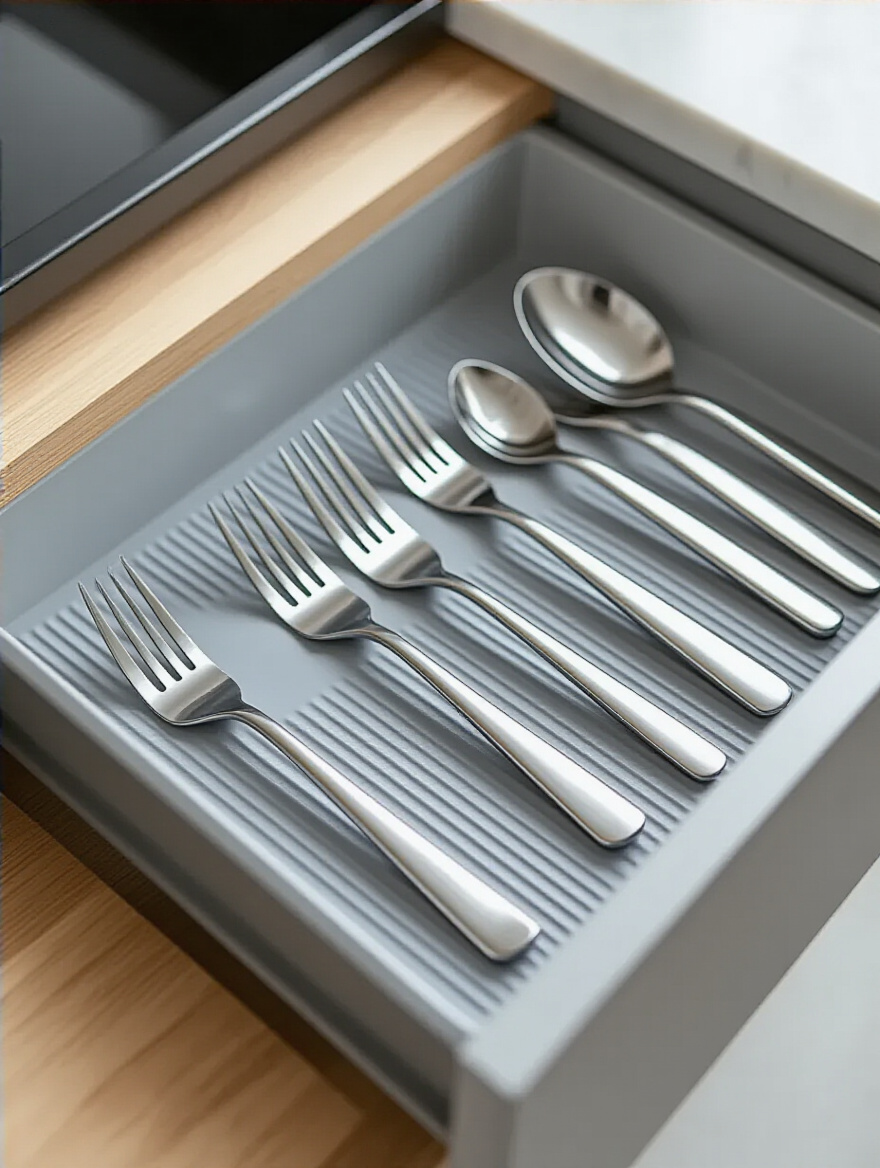
That clattering sound of glasses shifting or plates sliding is the sound of your organizational system failing. Liners provide a high-friction foundation that keeps everything in its place. Your neatly stacked bowls stay neatly stacked. Your glasses don’t migrate to the back of the cabinet. It’s a simple, inexpensive detail that makes your whole system more stable and permanent.
Think of it as mulch in a garden. It protects the soil, suppresses weeds (chaos), and helps everything stay where you planted it. Don’t skip this step.
Enhancement: Maximizing Functionality and Accessibility (Part 1)
With a solid structure in place, we can now add features that elevate the space from simply functional to truly effortless. This is the difference between a basic patio and a welcoming outdoor room with a fire pit and comfortable seating. These enhancements solve those tricky, persistent problems and make your kitchen a genuine pleasure to work in.
13. Integrate Lazy Susans (Turntables) for Effortless Corner Cabinet Access
Corner cabinets are notoriously awful. Without a good system, the only things that live in them are items you’ve completely forgotten you own. A Lazy Susan, or turntable, is the classic solution for a reason: it works. By putting your oils, vinegars, or spices on a turntable, you can simply rotate it to bring whatever you need to the front.
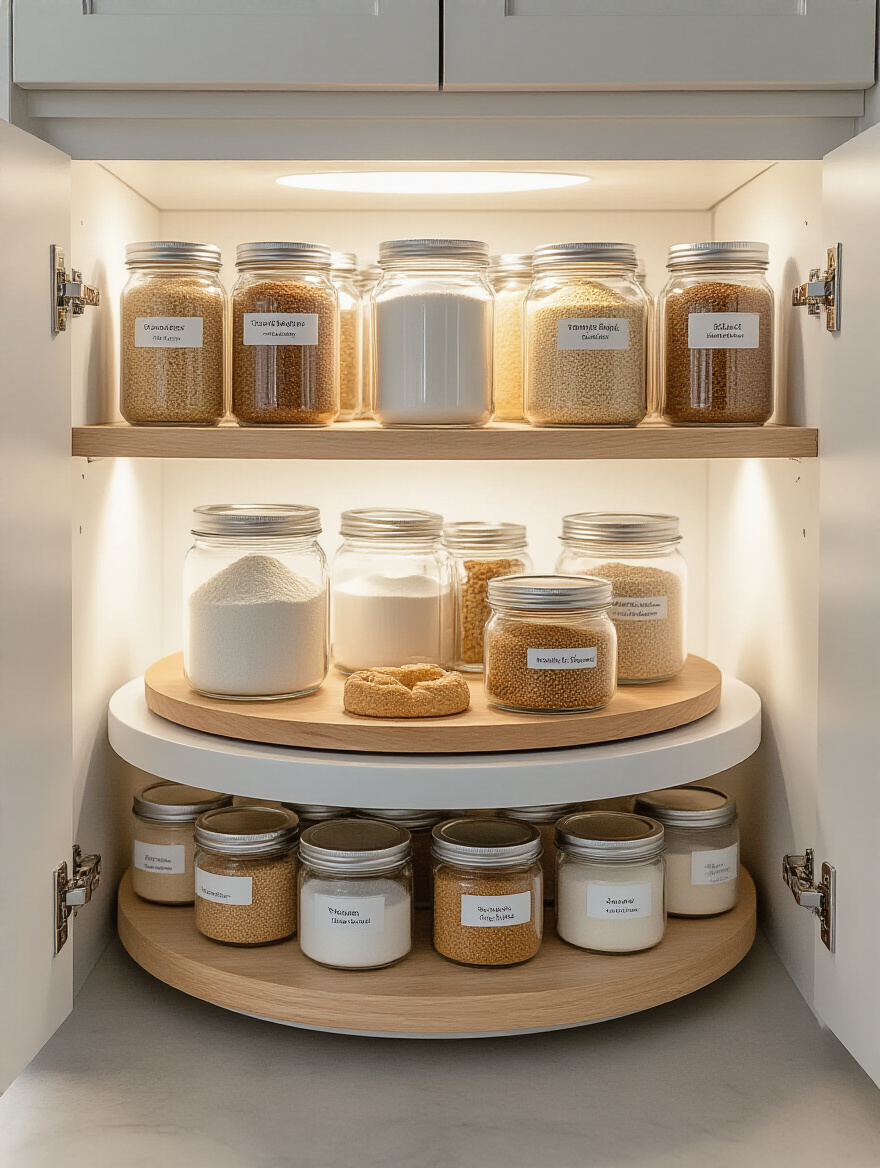
This is especially critical in those L-shaped “blind” corner cabinets. A kidney-shaped pull-out or a multi-tiered turntable can reclaim a massive amount of unusable space and make it one of the most functional spots in your kitchen. It’s the most effective way to solve the geometry problem of a square corner.
The constant is motion. A static shelf in a deep corner is a design flaw. Introducing rotation brings everything into the light and makes the entire volume of the cabinet usable.
14. Use Vertical Dividers for Baking Sheets, Cutting Boards, and Platters
Stacking flat things like baking sheets, cutting boards, and serving platters is one of the biggest sources of kitchen frustration. To get the one on the bottom, you have to lift the entire heavy, noisy stack. It’s terrible. The solution is to store them vertically, like files in a filing cabinet.
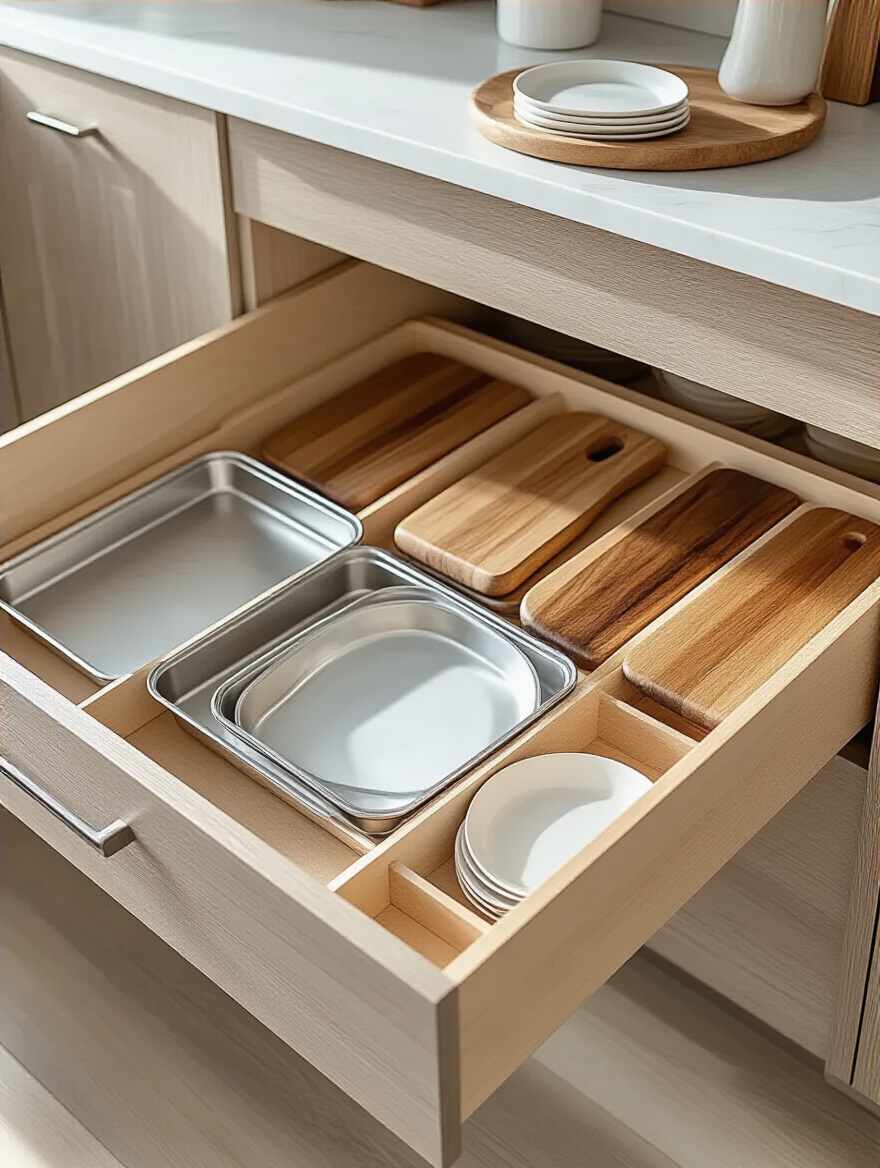
Simple, sturdy wire dividers create individual slots for each item. This allows you to slide any piece out independently without disturbing the others. It’s a revelation. You can install these in a lower cabinet or, my favorite spot, the tall, narrow cabinet above the refrigerator that’s usually wasted space.
This simple shift from horizontal stacking to vertical filing will save you time, effort, and the grating sound of metal scraping on metal. You’ll wonder why you ever did it any other way.
15. Install Pot and Pan Organizers for Stackable Storage and Easy Retrieval
Like baking sheets, pots and pans are a nightmare to stack. It’s noisy, it’s precarious, and it’s a great way to scratch up your non-stick cookware. A dedicated pot and pan organizer, especially a pull-out one for a base cabinet, changes everything.

These systems often have adjustable dividers that allow you to store pots and pans on their sides. Heavy-duty gliding racks let you pull the entire collection out for easy access. There are also tiered racks that allow you to “stack” pans without them ever touching each other, so you can grab the one you need from its own shelf. Lid organizers are also a must, either mounted to the door or as part of the main rack.
This is about protecting your investment. Good cookware is expensive. Storing it properly not only makes it easier to use but also extends its life significantly.
16. Create a Dedicated Cleaning Supply Zone Under the Sink with Caddies
The space under the sink often becomes a damp, chaotic mess of bottles, sponges, and half-used rolls of paper towels. The best way to tame this area is with a dedicated caddy. This keeps all your essential cleaners in one portable container, so you can grab the whole thing and take it with you to tackle a spill anywhere in the house.
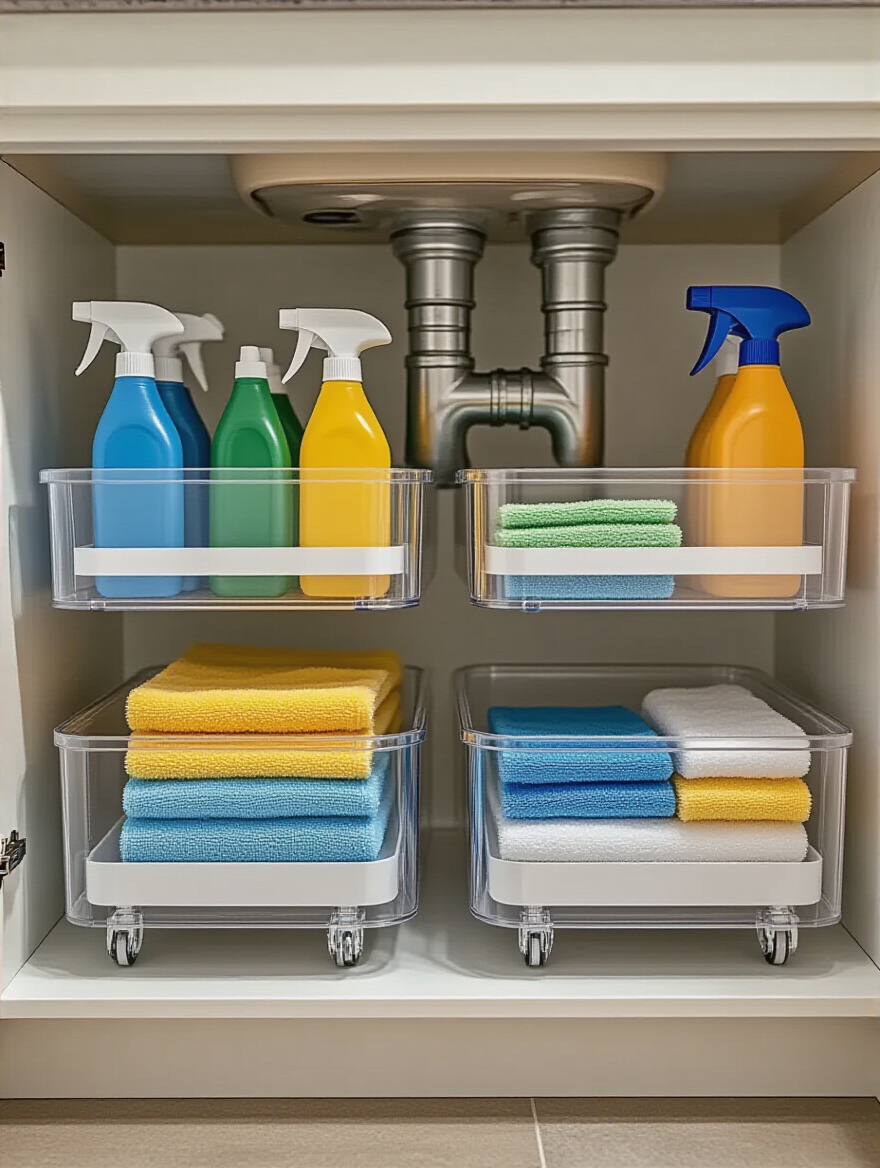
Look for a two-tier pull-out organizer designed to fit around the plumbing. These clever designs use the awkward vertical space on either side of the pipes, doubling your organized storage. It gets bottles off the bottom of the cabinet, preventing those sticky rings and making it easy to wipe up leaks.
A clean, organized under-sink area sets the tone for the rest of the kitchen. By turning this forgotten space into a functional hub, you eliminate one more source of daily friction.
Enhancement: Maximizing Functionality and Accessibility (Part 2)
We continue to refine our system, moving from physical organizers to strategic habits. These are the learned behaviors that maintain the balance we’ve created. Like knowing the right time to prune or water, these systems ensure the long-term health and sustainability of your organized kitchen, making it work for everyone in the house.
17. Apply Labeling for Instant Identification and Consistent Placement
Once you have everything organized into zones and containers, you need to label it. I know it feels a bit much, but trust me, this is the glue that holds the whole system together. Labels remove all guesswork. You (and everyone else in your house) know exactly what’s inside a container and where it’s supposed to go when it’s time to put it away.
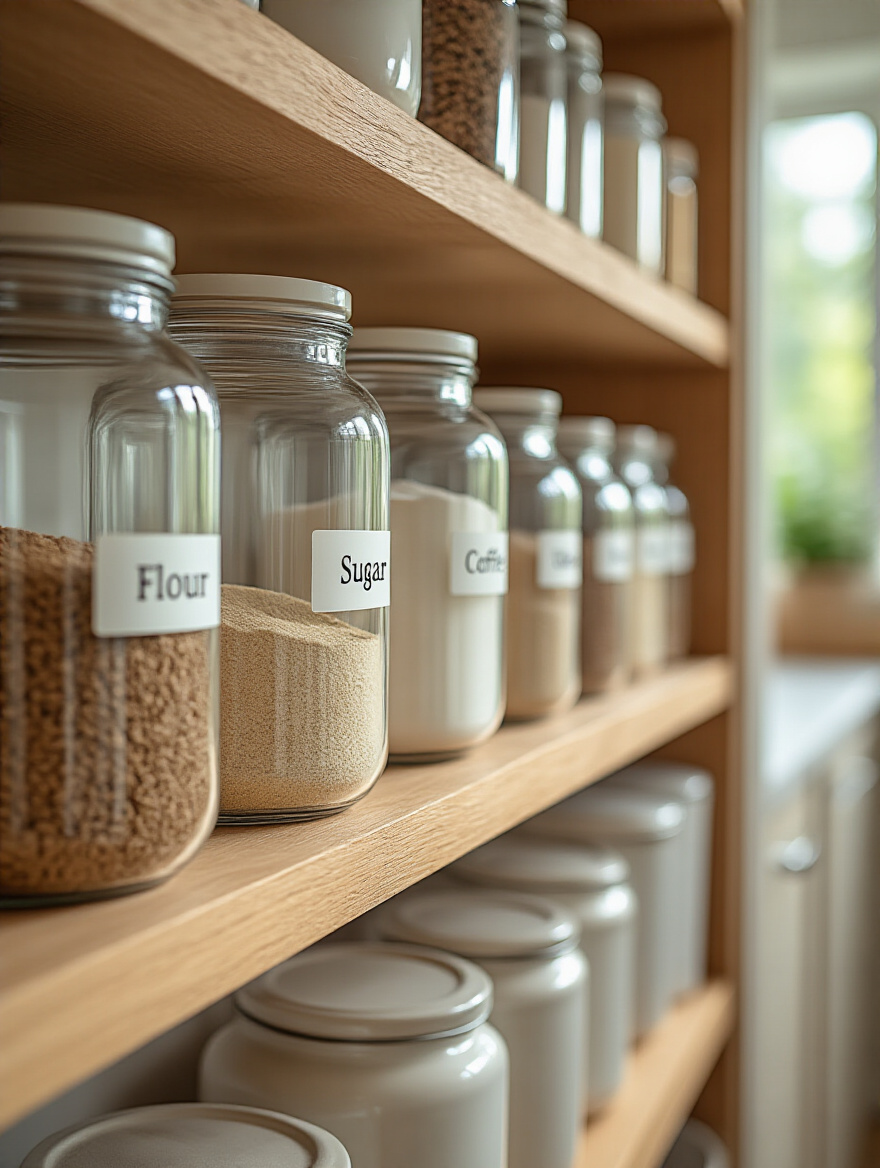
It doesn’t have to be fancy. A simple label maker or even just masking tape and a marker will do. Label the shelf where the bin goes, and label the bin itself. This creates a foolproof system that ensures things are returned to their proper home, which is half the battle of staying organized.
Think of them as plant markers in a garden. You need to know what you planted where, especially when you can’t see what’s growing. Labels provide clarity and prevent your carefully planned system from devolving back into chaos.
18. Implement a “First In, First Out” (FIFO) System for Pantry Staples
This is a simple system professional kitchens use, and it’s brilliant for reducing food waste at home. The principle is easy: First In, First Out. When you buy a new can of tomatoes, you put it behind the can you already have. This ensures you’re always using the oldest items first.
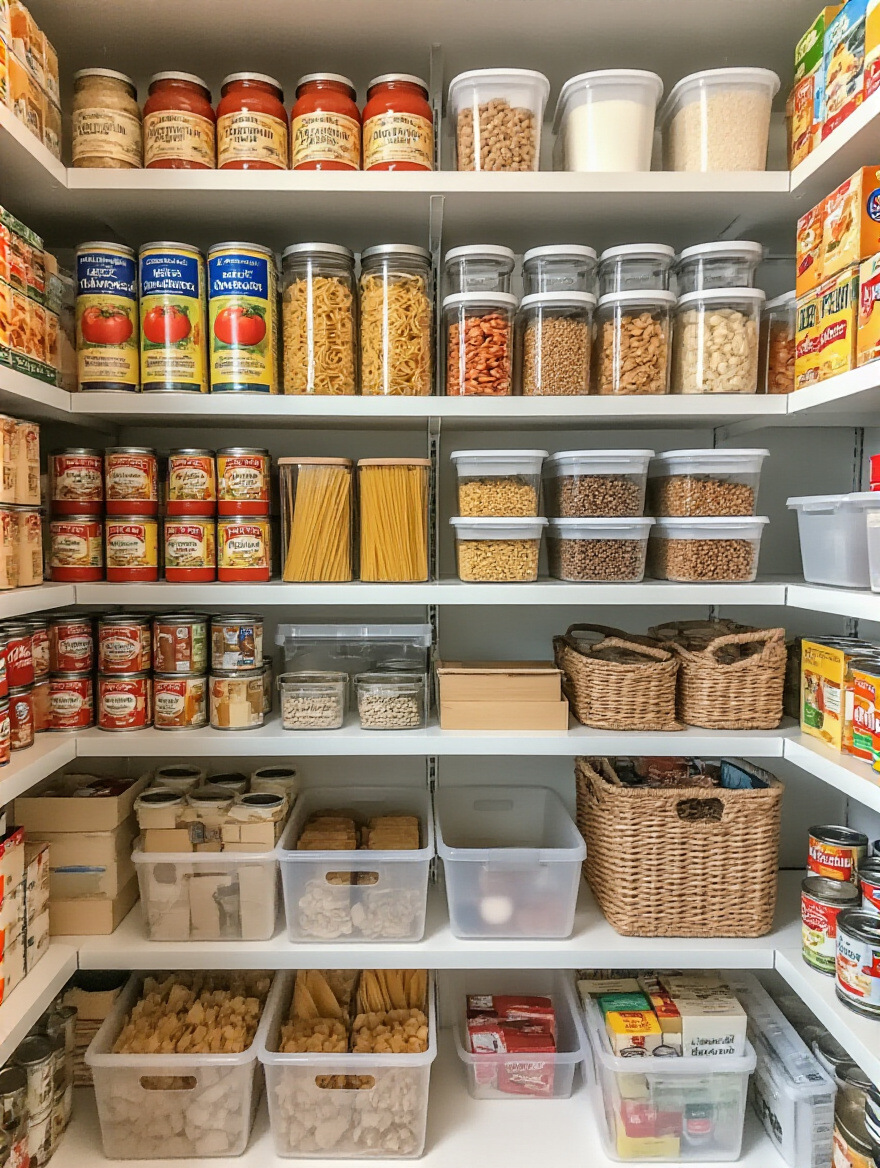
This single habit prevents you from discovering expired food in the back of your pantry and saves a surprising amount of money over time. It requires a bit of discipline when you’re unpacking groceries, but it quickly becomes second nature. It’s the kitchen equivalent of crop rotation, ensuring the soil (your pantry) stays fresh and productive.
Combine FIFO with your clear containers and tiered risers, and you’ll have a pantry that runs with maximum efficiency, minimizing waste and ensuring your ingredients are always at their best.
Optimization: Maintenance and Advanced Storage Strategies (Part 1)
A beautiful garden requires ongoing care, and so does an organized kitchen. This final section is about stewardship. It’s about building in the rhythms of maintenance that keep your system healthy and prevent clutter from ever taking root again. These strategies ensure your kitchen remains adaptable, functional, and efficient for years to come.
19. Schedule Regular Mini-Decluttering Sessions to Prevent Accumulation
The biggest mistake people make is thinking organization is a one-time project. It’s not. It’s a practice. To prevent a massive, soul-crushing clean-out every year, schedule a quick 10-minute “maintenance” session once a week. It’s like pulling a few weeds every time you walk through the garden—it never gets overwhelming.
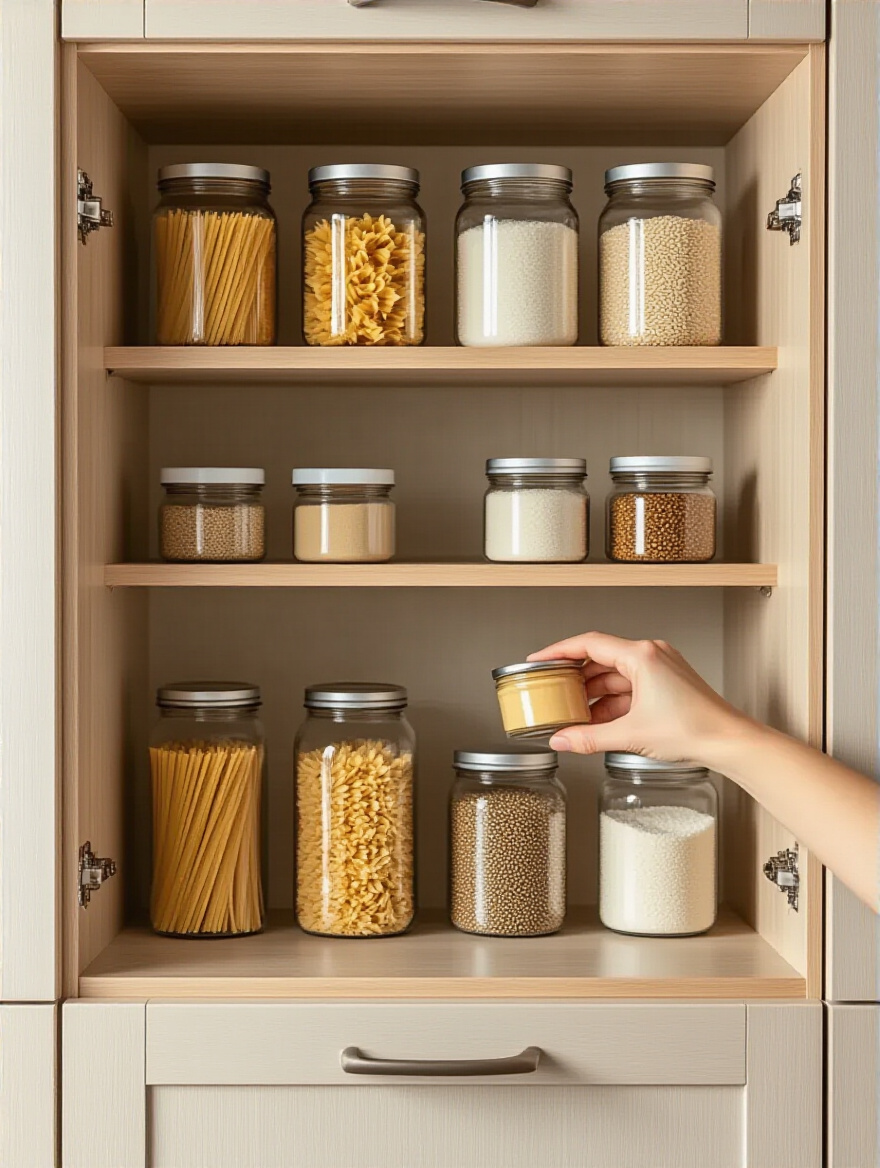
Choose one small spot—a single drawer, one pantry shelf, the spice rack—and tidy it up. Wipe it down, put things back in order, and assess if anything has crept in that doesn’t belong. That’s it. Ten minutes. Over the course of a month, you’ll have effortlessly maintained your entire kitchen.
This habit transforms maintenance from a dreaded chore into a simple, manageable routine. It respects the systems you’ve built and ensures they continue to serve you well.
20. Conduct Bi-Annual Deep Cleaning and Reassessment of Cabinet Needs
Twice a year, in the spring and fall, it’s time for a deeper check-in. This is like the seasonal garden cleanup where you cut back perennials and amend the soil. For your kitchen, it means taking a couple of hours to fully empty your pantry and high-traffic cabinets. Wipe them down completely and reassess if the system is still working for you.
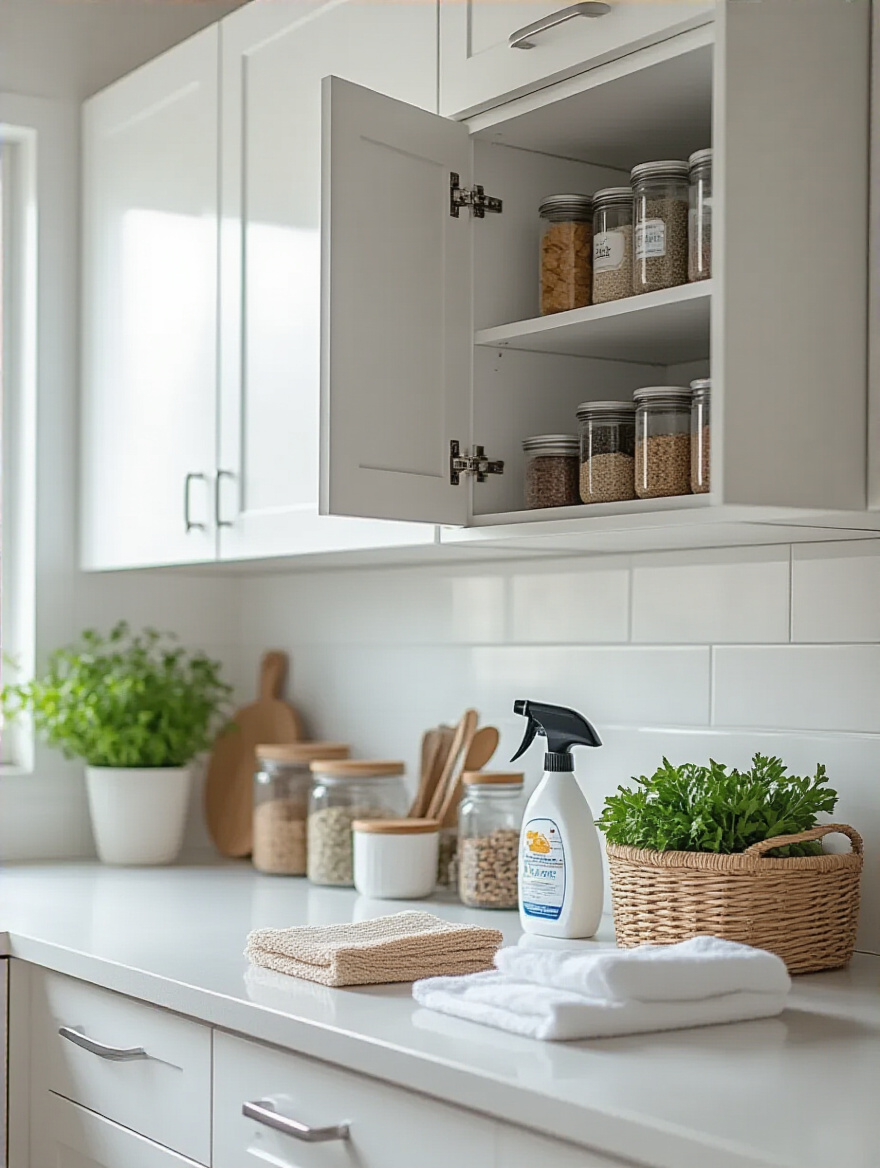
Life changes. You might pick up a new cooking hobby, or the kids might move on from needing sippy cups. This is your chance to adapt your system. Is that shelf for snacks still relevant, or could it be better used for something else? This regular reassessment keeps your kitchen perfectly aligned with your current life, not the life you had a year ago.
This isn’t about starting over. It’s about pruning and refining the system you already have, ensuring it remains healthy and productive.
21. Embrace Zone Organization: Group Like Items by Kitchen Function
We touched on this in the planning phase, but it’s worth a deeper dive as an advanced strategy. A truly optimized kitchen has designated zones for every primary function. It’s about designing your space for workflow, just like a well-designed garden has a path that leads you effortlessly from the potting bench to the vegetable beds to the compost bin.
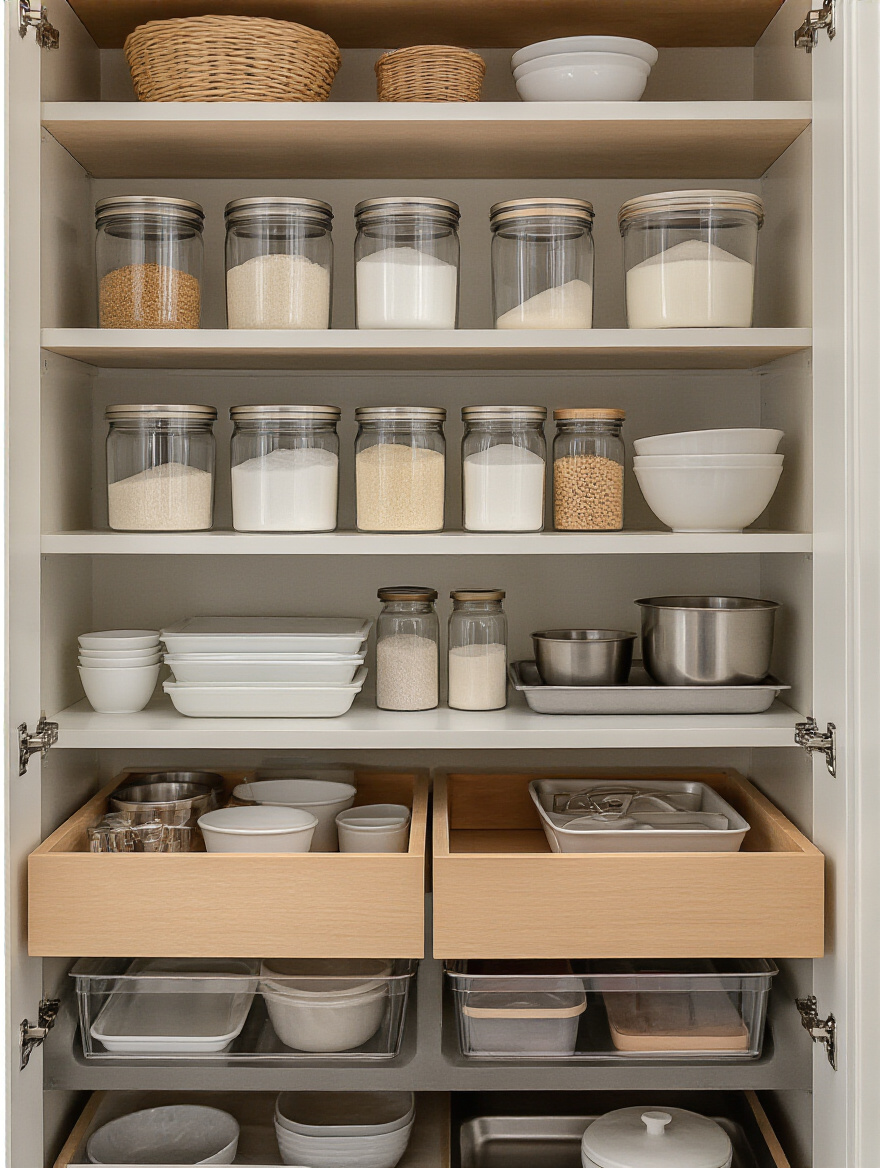
“A well-zoned kitchen reduces physical and mental effort, making the entire act of cooking feel less like a task and more like a creative flow.”
Establish a Prep Zone (knives, cutting boards, mixing bowls), a Cooking Zone (pots, pans, utensils, oils near the stove), a Baking Zone, a Coffee/Breakfast Zone, and a Cleaning Zone (under the sink). When everything you need for a task is within arm’s reach, you eliminate frantic searching and wasted steps. This is the secret to a kitchen that feels calm and efficient, even during a chaotic family dinner.
22. Leverage Cabinet Interior Lighting Solutions for Improved Visibility
You can have the most organized cabinet in the world, but if it’s dark, it’s still frustrating to use. Adding lighting inside your cabinets and pantry is a game-changing enhancement. It’s like adding landscape lighting to a garden—it highlights key features, improves navigation, and makes the whole space infinitely more usable after dusk.
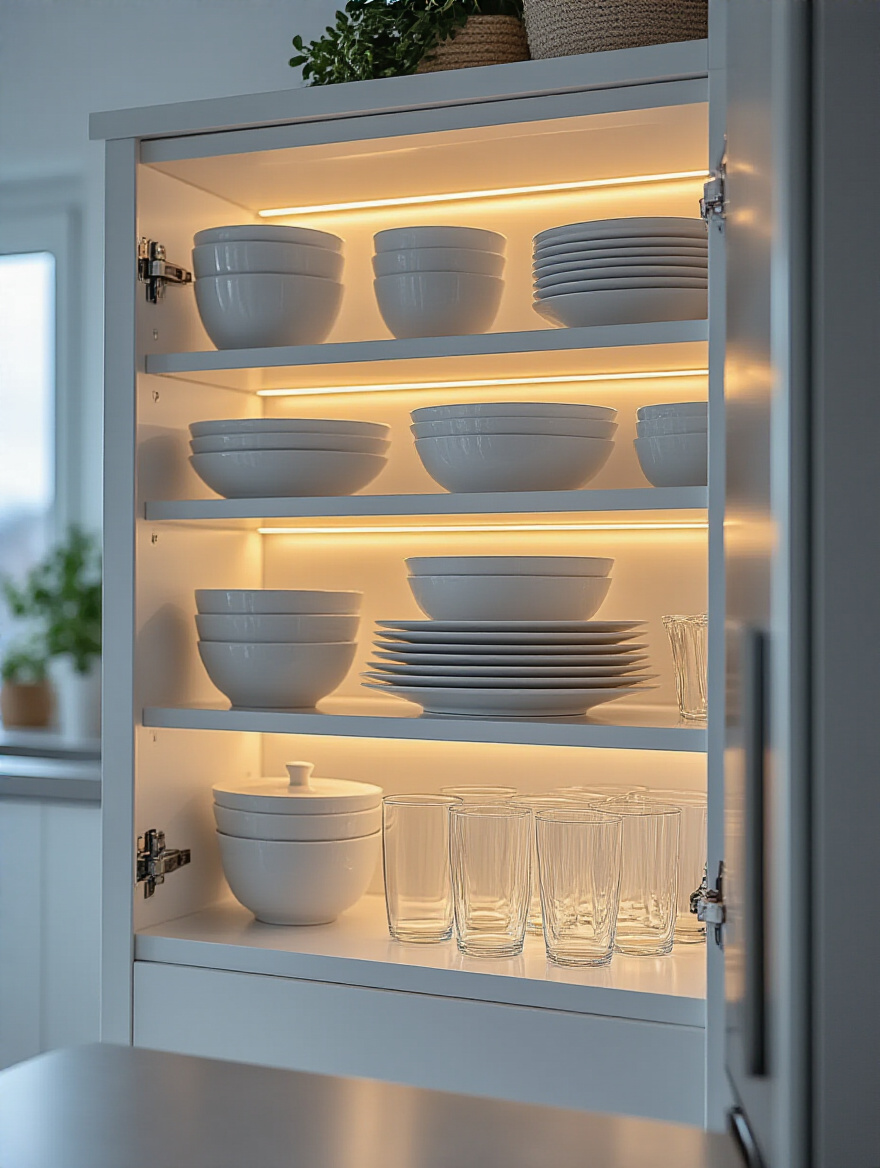
Inexpensive, motion-activated LED strip lights are perfect for this. They turn on when you open the door and turn off when you close it. Suddenly, you can see everything, right to the very back. This simple upgrade makes your beautifully organized spaces even more functional and eliminates those dark corners for good.
This isn’t a luxury; it’s a core component of accessibility. Visibility is everything when it comes to maintaining an efficient system.
Optimization: Maintenance and Advanced Storage Strategies (Part 2)
Finally, let’s talk about longevity and adaptability. A truly great design, whether in a landscape or a kitchen, is one that can evolve. This is about building solutions that are not only perfect for you today but are flexible enough to meet the needs of tomorrow.
23. Consider DIY Solutions for Unique Cabinet Challenges and Custom Fits
Sometimes, you have a weirdly shaped cabinet where no standard organizer will fit. Don’t just give up on that space. This is where a little DIY can be incredibly powerful. A custom-cut piece of plywood can become a perfect vertical divider or a shelf placed at just the right height.
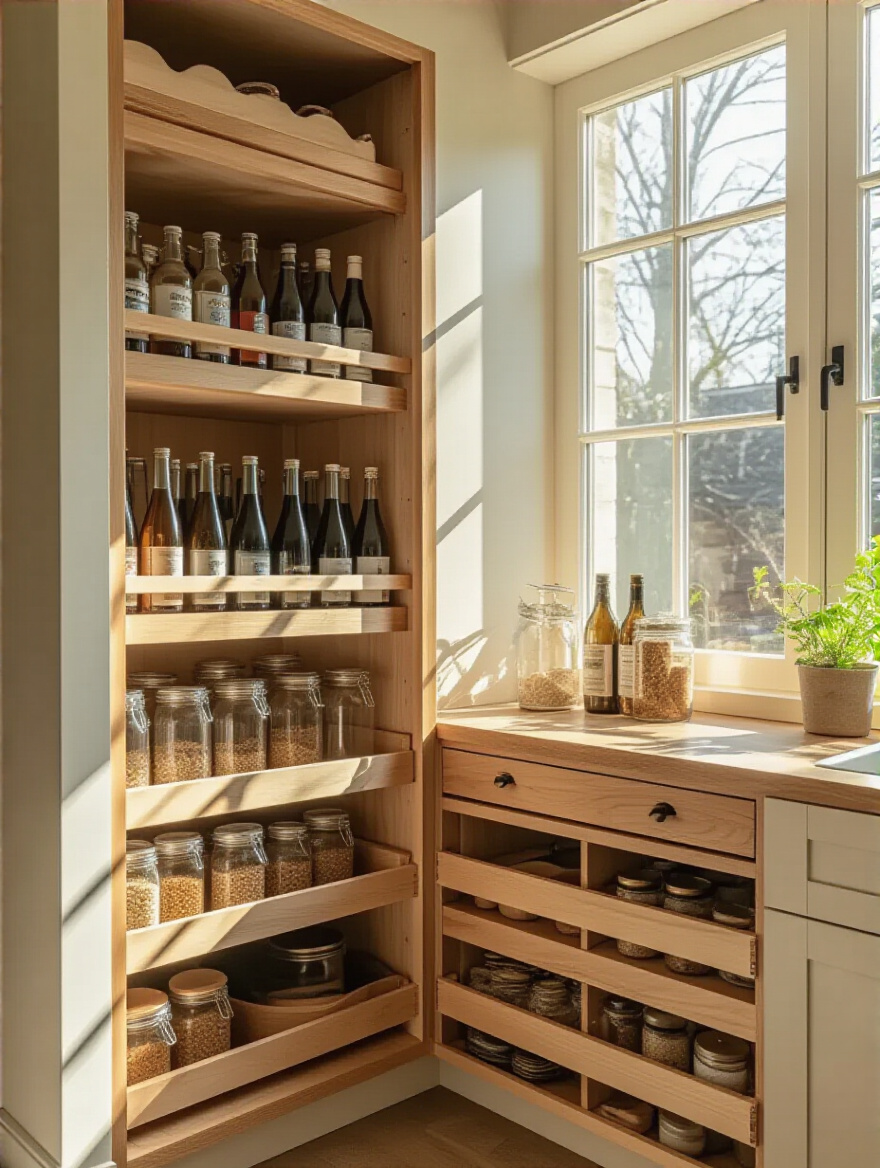
You don’t have to be a master woodworker. Simple solutions like tension rods can be used vertically to create makeshift dividers for baking sheets, or horizontally to hang spray bottles by their trigger handles. It’s about looking at an awkward space as an opportunity for a creative solution rather than a problem.
Getting a custom fit maximizes every last inch, turning a previously useless void into a perfectly tailored storage spot. This is the ultimate expression of working with your space, not against it.
24. Future-Proof Your Storage: Plan for New Appliances or Family Growth
A static system is a brittle one. The best designs are resilient and adaptable. When organizing, try to leave a little bit of breathing room—what architects call “negative space.” Don’t fill every single shelf to capacity. Leaving about 10% of your space flexible allows you to accommodate a new appliance or a shift in shopping habits without having to redo everything.
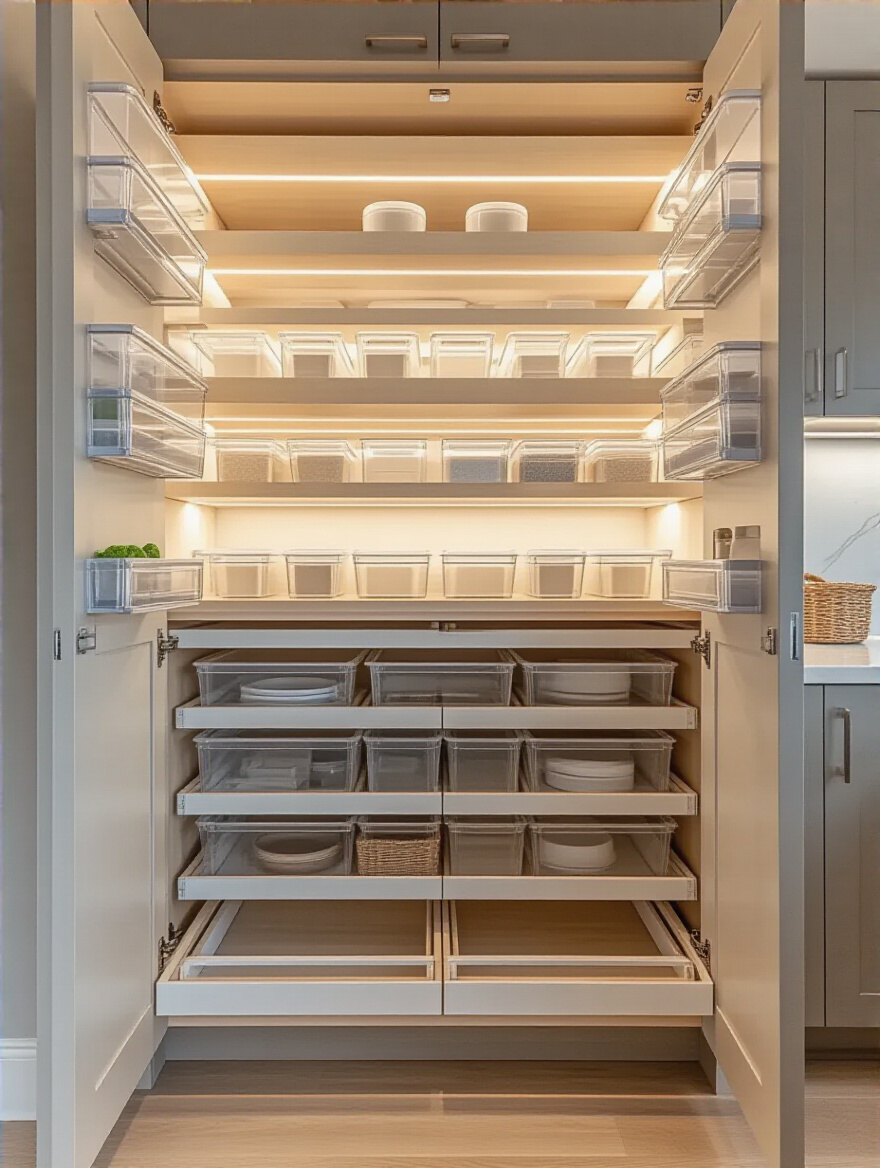
Choose modular and adjustable systems whenever possible. Shelves that can be moved, dividers that can be repositioned, and bins that can be repurposed give you the ability to adapt over time. When you plant a sapling, you plan for the full-grown tree. Do the same with your kitchen. Think about what your life might look like in a few years and build a system that can grow with you.
This forward-thinking approach is the key to creating a kitchen that doesn’t just get organized, but stays organized for the long haul.
Conclusion
There you have it—the real story on creating a kitchen that truly works. It’s not about buying every trendy organizer you see. It’s about building a solid foundation, choosing the right tools for the job, and cultivating habits that maintain the natural order you’ve created. A kitchen that flows effortlessly is the heart of a home that lives beautifully, connecting your indoor tasks with your outdoor pleasures.
The goal is to reduce friction in your daily life so you have more time and energy for the things that matter—like enjoying that glass of wine on the patio without a chaotic kitchen nagging at the back of your mind. You have the blueprint. Start with one drawer or one cabinet this weekend. That single step will build momentum, and soon you’ll have a space that feels less like a storage area and more like the functional, serene heart of your home.
